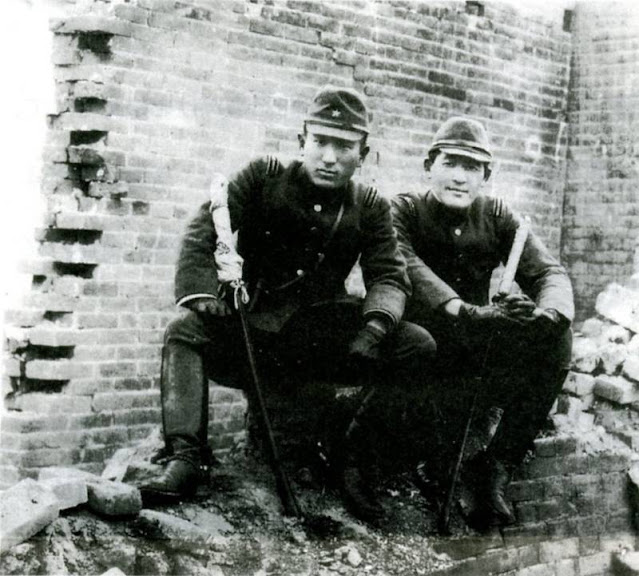The Gruesome Contest Between Two Soldiers Trying To Kill 100 With Their Samurai Swords
By Wyatt Redd
Published January 16, 2018
During the Second Sino-Japanese War, a Japanese
newspaper reported on the barbaric killing competition as though it were a
sporting event.
Wikimedia CommonsAn article reporting on the “Contest
to Cut Down 100 People.”
In 1937, during the Second Sino-Japanese War, the
Empire of Japan invaded China, and for the next eight years, committed horrific
atrocities against the civilian population. But while the international
press was reporting on the brutality of Japanese troops, newspapers in Japan
were looking for stories of wartime heroism. One of the stories they quickly
settled on was that of two officers and an unusual contest.
Just after the start of the invasion, the Osaka
Mainichi Shimbun ran an article titled “Contest to kill 100 People using a
sword.” As the article explained, two officers, Tsuyoshi Noda and Toshiaki
Mukai, had settled on a private competition to see which of them could be the
first to kill 100 enemy soldiers with their katanas. By the time the paper
first reported the story, the competition was already fierce.
“Since leaving Wuxi,” the paper reported, “one has
already killed fifty-six men, and the other has succeeded in killing
twenty-five.” Over the next few days, the paper followed the two soldiers,
keeping careful track of their scores. “Second Lieutenant N broke into an enemy
pillbox…[and] killed four enemy,” the paper continued, “When Second Lieutenant
M heard this, he invaded an enemy camp at Henglinzen…and laid fifty-five enemy
low with his sword.”
Wikimedia
CommonsTsuyoshi Noda and Toshiaki Mukai
With that astonishing bit of bloodshed, Second
Lieutenant Mukai apparently felt pretty good about his odds of winning. “With
things going like this,” he reportedly said, “I’ll probably cut down a hundred
by the time we reach Danyang… You’re going to lose.” But Noda promised that “By
the time we reach Danyang, I’ll show you what kind of record I can rack up.”
Meanwhile, the paper was following the results of the
contest as though it were a sporting event. Reporters caught up with the
Lieutenants just after the army left Danyang. “It’s 89-78 in the ‘Contest To
Cut Down A Hundred,’ A Close Race, How Heroic!,” the headline read. While
neither Mukai (89) nor Noda (78) had realized their goal of reaching 100 by the
time they reached Danyang, they would have plenty of opportunities to kill in
Nanking.
The Japanese Army reached Nanking, the capital of the Republic of China, on Dec. 13, 1937. What followed was a month-long orgy of violence as Japanese troops began to massacre the civilian population of the city. Looting, murder, and gang rapes were all widespread, and it’s estimated that around 300,000 people died during the “Rape of Nanking,” as the incident came to be known.
Wikimedia
CommonsA Japanese soldier beheading a Chinese prisoner.
The reporters who caught up with Mukai and Noda didn’t
report on the massacres, of course, but they noted that both men had
already passed their goal. Noda had reportedly killed 105, while Mukai had
killed 106. Neither man seemed to think much of killing so many people.
Although Mukai was apparently a bit upset about some damage to his sword, which
was “marred because I sliced someone down the middle, together with his
helmet.”
In the frenzy of killing in Nanjing, neither was sure
who had passed the 100 mark first. So, the lieutenants cheerfully agreed to
extend the contest to 150. But while the papers in Japan presented the two men
as cutting down enemies armed with guns, the truth was far less heroic. In
fact, Mukai and Noda were largely killing defenseless prisoners.
As Noda later admitted:
“Actually, I didn’t kill more than four or five people
in hand-to-hand combat. We’d face an enemy trench that we’d captured, and when
we called out “Ni, Lai-Lai!” (You, come on!), the Chinese soldiers were so
stupid, they’d rush toward us all at once. Then we’d line them up and cut them
down.”
In fact, there’s some doubt about whether the account
of the contest is even accurate. Many have argued that the numbers involved
were probably inflated. Some have even claimed that it never happened at all.
Noda himself claimed that there was a contest, but that it wasn’t as big a deal
as the newspaper made it out to be.
Moriyasu
Murase/ Wikimedia Commons.Bodies stacked by a river during the Nanking Massacre.
Ultimately, both men were tried and executed as war
criminals after Japan’s defeat. But in 2003, the families of Mukai and
Noda sued the newspaper that reported on the contest. They argued that
the episode was completely invented and that it damaged the reputations of the
two lieutenants. However, the court disagreed, saying, “the contest did occur,
and was not fabricated by the media.”
Since the war, the contest and the subject of the
Japanese massacres in China, in general, have been hotly disputed. Many
right-wing nationalists in Japan are quick to dismiss any accounts of Japanese
soldiers killing civilians in China as lies. But there’s little doubt that the
contest itself did take place and was part of a wider pattern of cruelty on the
part of the Japanese towards Chinese prisoners.




No comments:
Post a Comment
Note: Only a member of this blog may post a comment.